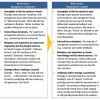Business Transformation Requires Transformational Leaders
Leadership and teaming skills are front and center in times of rapid change. Meet today’s constant disruption head on with expert guidance in leadership, business strategy, transformation, and innovation. Whether the disruption du jour is a digitally-driven upending of traditional business models, the pandemic-driven end to business as usual, or the change-driven challenge of staffing that meets your transformation plans—you’ll be prepared with cutting edge techniques and expert knowledge that enable strategic leadership.
Recently Published
Cognitive Computing
Today we are witnessing a new round of interest in AI and knowledge-based computing that is currently being called cognitive computing. This new round of commercial AI is based on the hugely more powerful computing platforms we have available today. Moreover, it is based on new AI techniques — with the emphasis on neural networks rather than business rules. Business rules provided the basis of some great expert systems, but they didn’t provide a basis for software systems that could learn and adapt — and neural networks do provide these advantages.
While theoretical discussions of decisions involving IT-related ethics are interesting, this past year highlighted the real effects of ignoring IT ethics in business decisions.
Applied Foresight Meets Transdisciplinary Collaboration
Among a myriad of changes, we have seen obsolete technologies mercilessly replaced, witnessed a couple of global economic collapses, and several products and services that we could never have imagined before — like the Internet — have become part of our daily lives. Whenever I see new, life-changing technology, I can’t help thinking: how did we get here so fast? Naturally, countless factors come into play in answering such a question; this Executive Update discusses two of my favorites: applied foresight and transdisciplinary collaboration.
As has been our tradition for the last several years, we've compiled the five most intriguing articles published by the Business Technology & Digital Transformation Strategies practice this year for today's Advisor. How did we come up with this list? We chose the articles that garnered the most feedback from Cutter Members and clients and those that created controversy among Cutter Senior Consultants and Fellows.
Question leadership is a question-based management principle not a bumper sticker. Most brilliant, innovative leaders know that leading by asking questions is a more powerful leadership style than just having the “right” answers, and gets you not only better business and organizational outcomes, but also more widespread employee — and customer and stakeholder — commitment. Moreover, asking the “right” questions, in the right order, communicates the goals you want to achieve.
Design thinking — a method for spurring creativity in innovation and problem-solving in business — has gained popularity among managers over the past few years. The method is inspired by the way in which professional designers work and can be applied by professionals with backgrounds other than design. The idea is that the traditional, highly analytical ways of thinking in business are not very effective for coming up with new and original approaches to tackle specific problems, or to renew a company's strategy, processes, or products. Instead, we can learn much from the way designers think. So what happens when design thinking meets business? What are the key mechanisms — or activity and thinking patterns — that the method seeks to promote in the teams practicing it? And how can a company implementing design thinking enable its teams to execute the design thinking process successfully?
In this report, the author first briefly clarifies what she means by design thinking. This is to avoid confusion that otherwise may arise from the different meanings associated with the term. Subsequently, she provides a short introduction to the method itself, and then introduces two cases and their design thinking practice. Next, she presents a framework of findings and explain the different concepts of the framework and their interconnections through examples from the cases. To extend this, she provides some additional thoughts on the presented findings before finally wrapping it all up in an alternative visualization of some of the key learnings from this report.
In this article, the authors argue the past is a poor playbook for the future when it comes to delivering real business value from technology. Whilst successful exploitation of legacy technologies is critical, the best practices that the IT industry has promoted and applied for the last 20 years have little value in this endeavor. In a fundamentally changed world, technologists will need to embrace and adopt "next practices" if they are to be successful. Before moving on to this challenge, though, we first need to establish that the situation we face as technologists has indeed changed fundamentally.
















